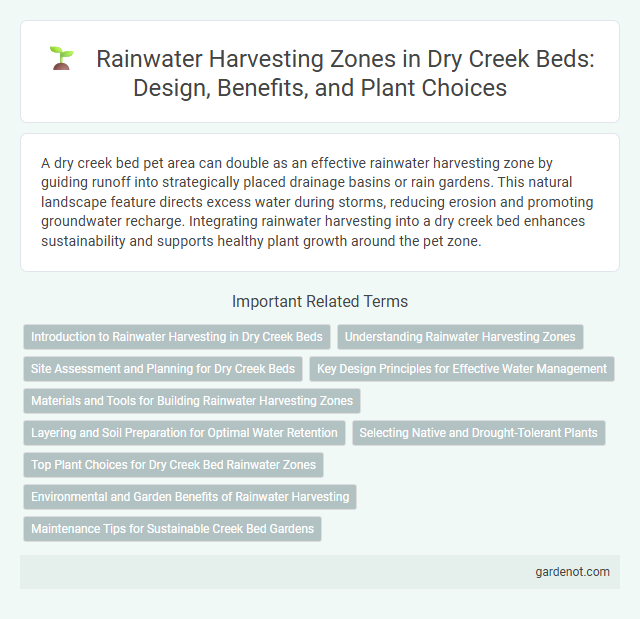A dry creek bed pet area can double as an effective rainwater harvesting zone by guiding runoff into strategically placed drainage basins or rain gardens. This natural landscape feature directs excess water during storms, reducing erosion and promoting groundwater recharge. Integrating rainwater harvesting into a dry creek bed enhances sustainability and supports healthy plant growth around the pet zone.
Introduction to Rainwater Harvesting in Dry Creek Beds
Rainwater harvesting in dry creek beds captures and stores runoff during rainfall events, transforming these natural channels into effective water management systems. By directing rainwater into porous creek beds, infiltration is enhanced, replenishing groundwater and reducing erosion. This sustainable practice supports local ecosystems, conserves water, and mitigates flood risks in arid and semi-arid regions.
Understanding Rainwater Harvesting Zones
Rainwater harvesting zones designate specific areas where water runoff is collected and stored to maximize reuse and reduce soil erosion. These zones are strategically designed based on topography, soil type, and rainfall patterns to optimize infiltration and minimize water loss. Implementing proper rainwater harvesting zones in a dry creek bed enhances groundwater recharge and supports sustainable water management for surrounding ecosystems.
Site Assessment and Planning for Dry Creek Beds
Site assessment for dry creek bed rainwater harvesting zones involves analyzing soil permeability, slope gradient, and existing drainage patterns to optimize water capture and infiltration. Planning requires selecting appropriate vegetation and permeable materials to reduce erosion and enhance groundwater recharge. Effective dry creek bed design balances hydrological dynamics with landscape integration to maximize sustainable water management.
Key Design Principles for Effective Water Management
Designing a rainwater harvesting zone in a dry creek bed requires strategic placement of infiltration basins to maximize water capture during runoff events. Incorporating native vegetation and permeable materials enhances soil absorption and reduces erosion, promoting groundwater recharge. Properly graded contours and sediment control measures ensure efficient water flow management while preventing sediment buildup and channel degradation.
Materials and Tools for Building Rainwater Harvesting Zones
Key materials for constructing rainwater harvesting zones in a dry creek bed include porous rocks, gravel, and permeable soil to facilitate efficient water infiltration and reduce runoff. Essential tools involve shovels for excavation, wheelbarrows for transporting materials, and levelers to ensure proper grading of the bed for optimal water retention. Incorporating geotextiles can enhance soil stability and prevent erosion, ensuring the longevity of the rainwater harvesting system.
Layering and Soil Preparation for Optimal Water Retention
In rainwater harvesting zones, layering with organic mulch, sand, and gravel enhances water infiltration and retention in dry creek beds. Proper soil preparation involves amending clay or sandy soils with compost to improve porosity and moisture-holding capacity. These techniques optimize water absorption, reducing runoff and supporting vegetation growth in arid environments.
Selecting Native and Drought-Tolerant Plants
Selecting native and drought-tolerant plants for a dry creek bed rainwater harvesting zone enhances water conservation by minimizing irrigation needs and maximizing absorption. Species such as California poppy, yarrow, and blue grama grass thrive in arid environments, improving soil stability and reducing erosion. Integrating these plants supports local ecosystems and creates sustainable, low-maintenance landscaping that efficiently manages stormwater runoff.
Top Plant Choices for Dry Creek Bed Rainwater Zones
Native grasses such as Blue Fescue and Switchgrass excel in dry creek bed rainwater harvesting zones due to their deep root systems that enhance soil stabilization and water absorption. Succulents like Sedum and Agave are ideal for their drought tolerance and ability to thrive in well-drained, rocky soils typical of dry creek beds. Complementary plants such as Lavender and Russian Sage offer both aesthetic appeal and resilience, supporting biodiversity while efficiently managing intermittent water flow.
Environmental and Garden Benefits of Rainwater Harvesting
Rainwater harvesting in dry creek beds enhances soil moisture levels, reducing dependence on municipal water and promoting sustainable garden growth. This method improves groundwater recharge and minimizes runoff, preventing erosion and nutrient loss in the landscape. Utilizing harvested rainwater supports native plant health, creating a resilient ecosystem that conserves water and fosters biodiversity.
Maintenance Tips for Sustainable Creek Bed Gardens
Regularly clearing debris and sediment from the dry creek bed ensures efficient rainwater flow and prevents blockages, enhancing the garden's sustainability. Inspecting and repairing erosion control measures like rocks and mulch protects soil integrity and maintains water absorption. Incorporating drought-tolerant plants reduces water demand and supports long-term ecological balance in rainwater harvesting zones.
Rainwater harvesting zone Infographic

 gardenot.com
gardenot.com